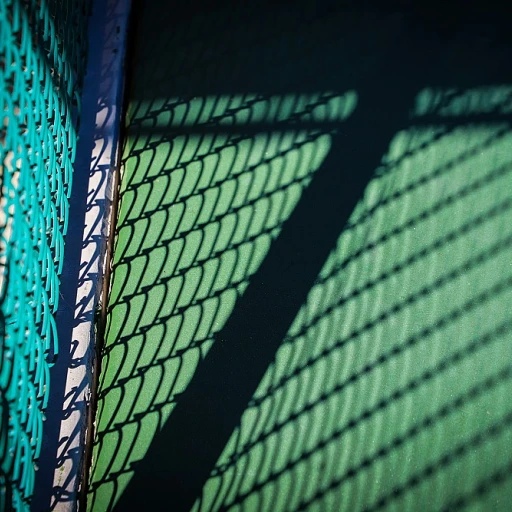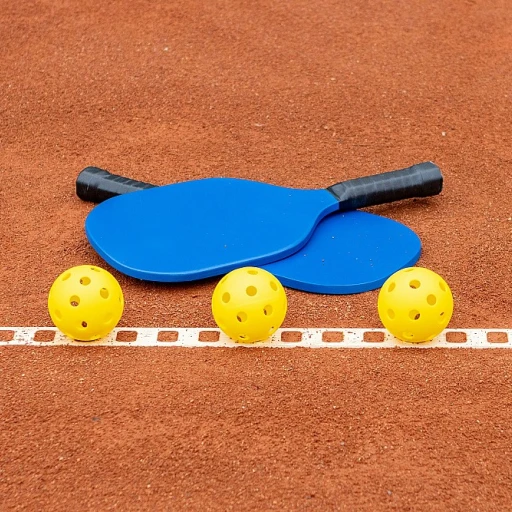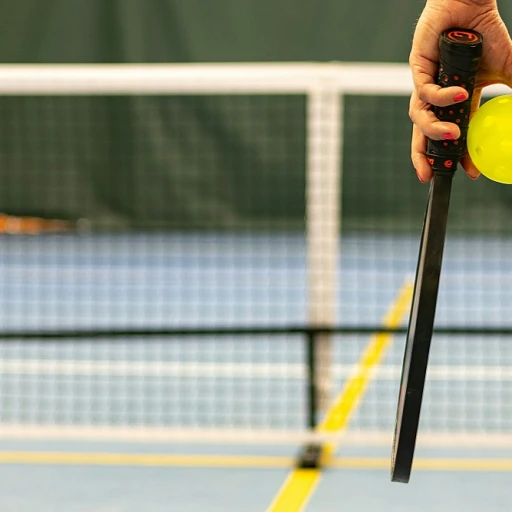
Understanding the standard pickleball court dimensions
Getting to grips with pickleball starts with knowing the dimensions of the court. For starters, a pickleball court measures 20 feet wide and 44 feet long. These measurements are consistent whether you're playing singles or doubles. According to USA Pickleball, these dimensions ensure the game’s consistency and fairness across different levels of play.
The nitty-gritty of pickleball court size
Unlike tennis courts, which can vary in size, the dimensions for a pickleball court are standardized globally. USA Pickleball sets the standards, ensuring that a pickleball court remains 20 feet by 44 feet no matter where you are in the United States or internationally. This strict adherence to size helps players adapt quickly from one court to another.
Similarities between singles and doubles play
Both singles and doubles matches are played on the same court. The only difference comes in strategy and player positioning. The dimensions do not change, making it convenient for venues and home courts alike. Players appreciate this because they don’t have to adjust to different court sizes.
Breaking down the specifics
The baseline runs parallel to the net and marks the back boundary on each end of the court. The court is divided into two service areas on each side, separated by a centerline. The service areas themselves are crucial for service play. The sections of the pickleball court provide clear, defined areas where play happens and where strategies unfold.
A quick look at the net and zones
The pickleball net stands at 36 inches high at the sidelines and 34 inches high in the middle, demanding precision in hitting from the players. Right in front of the net is the volley zone, often called the kitchen. This zone measures 7 feet from the net on either side and is where volleying is restricted, adding a layer of strategy to the game.
Comparing the playing surface
The pickleball court dimensions differ significantly from a tennis court. While a tennis court is 36 feet wide and 78 feet long, a pickleball court’s compact size of 20 by 44 feet allows it to fit comfortably within a standard tennis court, often enabling multiple pickleball courts to be set up where one tennis court used to be.
Differences between singles and doubles play
Singles vs doubles: does it change court size?
The court dimensions for singles and doubles pickleball are exactly the same, providing simplicity and consistency for players. A standard pickleball court measures 20 feet wide and 44 feet long regardless of the number of players. The consistency in court size ensures that both singles and doubles play can be seamlessly transitioned without needing to adjust the court measurements.
However, while the court dimensions remain unchanged, the strategy and play style in singles versus doubles can be quite different. In singles, players cover more ground, requiring greater agility and endurance. Doubles play emphasizes teamwork, coordination, and strategizing positions to cover the court effectively.
Service areas and the volley zone
The pickleball court is divided into several key zones and lines to facilitate gameplay. The baseline runs parallel to the net on both sides of the court, and the sidelines create the outer boundaries. The area between the net and the non-volley zone line, often called the 'kitchen,' is critical in pickleball strategy, as players cannot volley while positioned within this zone.
The service areas are also clearly marked, with a centerline dividing the court into left and right service zones. Players must serve diagonally from behind the baseline and aim to land the ball in the opposing service area, adding a layer of precision to the game.
How court lines affect play
The precise marking of lines and zones not only maintains the integrity of the game but also affects play dynamics. For instance, stepping into the non-volley zone during a volley, known as “foot fault” is a common beginner mistake and highlights the importance of spatial awareness on the court.
Lines like the centerline ensure that serves adhere to rules, while sidelines and baselines define the playable area, ensuring out-of-bounds balls are clearly identified. This meticulous court layout ensures fairness and consistency across games.
Detailed look at the pickleball net
Understanding the structure of a pickleball net
The net is such a crucial component of the game that even a slight deviation in its structure impacts play significantly. Pickleball nets have standard dimensions just like the courts, but let's dive into the specifics.
If you've ever played on a pickleball court, you've noticed that the net is always uniform. According to USA Pickleball, the regulation height for a pickleball net is 36 inches at the sidelines and 34 inches in the center. This slight dip in the middle is designed to ensure that the net is properly tensioned. The net itself is typically 20 feet wide, slightly longer than the width of the pickleball court, which is 20 feet wide itself.
One standout feature is the center strap - this ensures the 34-inch height is consistently maintained. Without this, the natural tendency of net materials would result in slack, leading to gameplay inconsistencies.
Materials for the net are usually high-quality polyethylene or similar filament, which can survive various weather conditions, whether you're playing in Washington or the sunny parts of America like Utah. These nets are frequently used in outdoor spaces so durability is key. USA Pickleball recommends using nets made from heavy-duty, functional materials for both competitive and casual games.
When it comes to choosing your net, one might opt for a portable pickleball net. This makeshift yet sturdy alternative is ideal for those who frequently move their setups or for communities without permanent courts. Examples of excellent portable nets include those from brands like Onix and Franklin Sports, which rank high in user reviews.
An interesting trend observed in the community is the increasing preference for pickleball courts over tennis courts due to the rising popularity and the lower costs and space requirements associated with building pickleball courts.
For those interested in more detailed comparisons and insights into similar racquet sports, check out this in-depth analysis of Pickleball vs Padel.
Marking the court: lines and zones
Drawing the lines: where precision matters
When it comes to marking a pickleball court, precision is key. The official size of a standard pickleball court is 20 feet wide and 44 feet long for both singles and doubles play. Proper measurements and accurate lines are essential for ensuring fair play and consistency across games.Key lines and their significance
The court layout includes several lines, each serving a crucial purpose during the game. The baseline runs parallel to the net at both ends of the court. It’s a critical guide for players during both service and volleys. The sideline marks the outer boundary of the court. For doubles, the full court is used – 20 feet wide – while singles matches also use the full court, unusual compared to other racket sports.Breaking down the non-volley zone
Arguably the most distinctive feature of a pickleball court is the non-volley zone, or as many call it, the 'kitchen’. This area extends 7 feet from the net on both sides of the court. Players are not allowed to volley the ball (hit it out of the air) while standing inside this zone, adding an extra strategic element to the game. This rule helps balance the game, reducing aggressive net play.Service areas: make or break
Another set of lines divides each side of the court into two service areas. These are separated by the centerline, running from the non-volley line to the baseline. Players must serve diagonally across the court, landing the ball within the opponent's service area. This division helps in distinguishing between left and right service courts, which keeps the game in order and tests a player's precision.Resurfacing and repainting
A well-maintained court surface is crucial for clear lines and consistent play. Over time, the paint might wear out due to weather and frequent use. In such cases, resurfacing and repainting the court become necessary. Many enthusiasts recommend using a specific outdoor acrylic paint suitable for sports courts to enhance both durability and visibility. Essentially, the lines and zones on a pickleball court aren't just random markings; they dictate the game's flow and fairness by ensuring every aspect has a defined space. Whether you're a novice setting up your backyard or an official maintaining a professional court, understanding these details can significantly enhance your playing experience.Court surface and materials
Choosing the right materials for your pickleball court
When you're getting into the specifics of building a pickleball court, picking the right surface material is key. The court surface directly impacts the way players move, ball bounce, and overall game experience. You'll regularly hear experts in America like those from USA Pickleball advocating for materials that enhance both durability and playability.
Generally, there are a few popular materials you can consider. Asphalt or concrete are commonly used for outdoor pickleball courts. They offer robustness, ensuring your court withstands weather conditions. An example is that most commercial pickleball courts, especially in places like Washington, utilize these materials for their standard pickleball court setup. Asphalt and concrete provide a consistently smooth playing surface but might need a specific coating to achieve the right grip and optimize the ball's bounce.
On the other hand, if the idea of outdoor courts doesn't throw you off, you might want to opt for indoor options. Hardwood floors are a favorite for indoor pickleball courts in gyms across the United States. They closely mimic the feel of a tennis court but tailored for the rapid volleys of pickleball. Plus, they come with the added benefit of being easier on players' joints compared to harder surfaces like concrete.
While surface choice is critical, don't overlook the importance of other materials that shape the court's feel. This includes proper demarcation of net lines and service areas, using high-quality paint resistant to fading and peeling. The net itself is another component requiring quality materials. Regulation pickleball nets should be 36 inches high at the sidelines and 34 inches at the center. Portable pickleball nets come with convenience if setting up a backyard pickleball court is more your speed.
When planning to build a pickleball court, considering the right materials is paramount to creating an optimal play area. Be sure to factor in local weather conditions, expected player traffic, and your budget as you make your decisions.
Building your own pickleball court
DIY pickleball court construction tips
So, you're dreaming of a pickleball court in your own backyard? You're not alone. It's not just about having a space to play; it's about having your slice of pickleball heaven. Let's break down what you need to know about building your own court.
First things first, you'll need the right amount of space. A standard pickleball court is 20 feet wide and 44 feet long. That's the minimum size for proper play. But remember, you’ll need extra space around the court for players to move around comfortably. The recommended total area is at least 30 feet wide and 60 feet long.
Next up, the surface. It’s crucial! The best surfaces are asphalt or concrete, which provide a smooth, hard, and durable playing space. Adding a specialized court surface such as acrylic can also help with traction and reduce strain on players' joints.
When it comes to the pickleball net, you'll need it to be 36 inches high at the sidelines and 34 inches high in the middle. You can find portable pickleball nets that meet these specs, allowing you to move and store them easily.
Marking the court with lines needs precision. The lines are typically 2 inches wide and should be of a contrasting color to the playing surface. You'll need to mark the sidelines, baseline, service areas, and the non-volley zone, also known as the kitchen. If you’re playing singles, the same court can be used without any extra markings.
Lighting your court is an excellent idea if you plan to play in the evenings. Proper illumination ensures safe and enjoyable play. Make sure the lights cover the entire play area evenly without creating shadows or blind spots.
One noteworthy tip: Reach out to local contractors who specialize in building pickleball courts. They can provide valuable insights and avoid costly mistakes. Moreover, the USA Pickleball Association has guidelines and resources to help you with the DIY process.
As you set up your pickleball haven, remember to check out our earlier discussions on the dimensions and differences between when playing singles and doubles. Those insights will help you tailor your court to suit the games you love best.
Comparing pickleball courts to tennis courts
Pickleball courts vs tennis courts: understanding the differences
When it comes to comparing pickleball courts with tennis courts, the variations are crucial for players and enthusiasts to understand. Pickleball courts are designed for a quicker-paced game with smaller dimensions compared to tennis courts.
Court size and dimensions
A standard pickleball court is 20 feet wide and 44 feet long, making it substantially smaller than a tennis court, which measures 36 feet wide and 78 feet long. The compact size of a pickleball court allows for faster games and quick rallies, providing a different dynamic compared to tennis.
Net differences and adjustments
The pickleball net stands at 34 inches high at the center and 36 inches high at the posts, while the tennis net is typically 36 inches at the center and slightly higher at the posts. This height difference accommodates the different ball types and game styles.
Court markings and zones
Pickleball courts feature unique markings, including the non-volley zone, or 'kitchen,' extending 7 feet from each side of the net, which plays a significant role in the game strategy. Tennis courts, however, have baseline and service line boundaries without an equivalent 'kitchen' area.
Court surfaces and materials
Both pickleball and tennis courts often use similar surface materials such as asphalt or concrete, but the smaller size of pickleball courts can make maintenance and construction more cost-effective. Some enthusiasts even convert parts of their backyard into a pickleball court due to its manageable size.
Adaptations for playing on tennis courts
Many communities repurpose tennis courts for pickleball by adding lines and using portable nets. This allows for flexibility and maximizes the use of available court space for different sports. According to USA Pickleball, converting existing tennis courts for pickleball play is a popular trend across the United States.
The differences in size, net height, and markings between pickleball and tennis courts significantly impact the play style and strategies employed in each sport. Whether you're a tennis player looking to try pickleball or converting a space for multi-use, understanding these differences is key.

-large-full.webp)


-large-teaser.webp)
